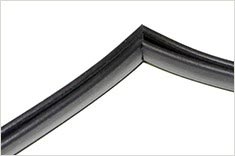EMI Shielding Products
- Custom Gasket Fabrication
- Connector Gaskets
- Bonded O Ring
- Custom Gaskets
- Conduct-O-Knit Knitted Wire Mesh
- Conduct-O-Seal Combo Gasket
- Conduct-O-Elastomer
- Conduct-O-Seal Oriented Wire in Silicone Gasket Material
- Conduct-O-Mesh Tape
- Conduct-O-Foam
- Conduct-O-Bond
- Optical Filters For Electronic Displays
- Shielded Vent Panels
- ESC Board Level Shielding
- 300 Series
Transmission Theory and Its Role in Enhancing EMI Gasket Efficiency
 Transmission theory is critical in understanding and improving the efficiency of EMI (Electromagnetic Interference) gaskets. This theory applies the principles of wave propagation and impedance matching to predict and enhance the shielding effectiveness (SE) of these gaskets.
Transmission theory is critical in understanding and improving the efficiency of EMI (Electromagnetic Interference) gaskets. This theory applies the principles of wave propagation and impedance matching to predict and enhance the shielding effectiveness (SE) of these gaskets.
Understanding Transmission Theory
Transmission theory deals with the behavior of electromagnetic waves as they pass through different media, considering factors like wave impedance and propagation characteristics. In the context of EMI gaskets, transmission theory is used to model and measure how well these gaskets can block or attenuate unwanted electromagnetic fields that could interfere with electronic devices.
Application of Transmission Theory in EMI Gaskets
EMI gaskets fill seams or gaps in electronic enclosures to prevent electromagnetic leakage. Their effectiveness is determined by their ability to create a low-impedance path between the seam edges, thereby reducing the potential difference and minimizing the radiated leakage fields.
- Measurement Methods: The traditional methods for measuring the SE of EMI gaskets include the aperture attenuation and current injection methods. However, these methods have limitations in terms of accuracy and frequency range. Transmission theory offers a more precise and repeatable approach.
- Controlled Impedance Fields: The impedance of the impinging and leakage fields can be controlled more accurately using transmission theory. This leads to better repeatability and accuracy in SE measurements. For instance, a GTEM (Gigahertz Transverse Electromagnetic cell) provides a controlled environment for generating and measuring electromagnetic fields.
- Error Estimation and Validation: Transmission theory helps estimate and minimize measurement errors. The SE is calculated by comparing the field intensity levels with and without the gasket installed. The method described involves using a semi-anechoic chamber and RF absorbers to reduce reflections and ensure accurate measurements.
Practical Implementation and Results
- Gasket Materials: Copper-nickel foam gaskets and Beryllium Copper finger-stock gaskets are commonly used materials. Transmission theory helps quantify the SE of these materials by considering factors such as material variations, seam geometry, and contact pressure.
- Measurement Setup: The SE measurements involve using a fixture to hold the faceplates and gaskets in place. The GTEM generates the test fields, and the radiated emissions are measured at specific frequencies. The ratio of the electric field intensities on either side of the gasket determines the SE.
- Results Analysis: The data shows that Beryllium Copper finger-stock gaskets generally provide better SE than Copper-Nickel foam gaskets. The measurements also indicate that SE levels are higher at lower frequencies except for gasket resonant frequencies.
Enhance the Performance of EMI Gaskets for Shielding
Transmission theory, a robust framework, helps evaluate and enhance the efficiency of EMI gaskets. Offering more accurate and repeatable measurement methods ensures that electronic enclosures can be better protected from electromagnetic interference. This optimistic outlook on the potential of transmission theory leads to improved performance and reliability of electronic devices, especially in environments with stringent EMI requirements.



